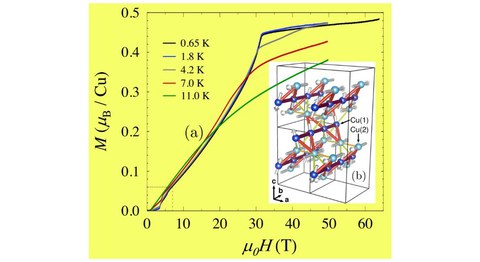May 31, 2021
Research: Atacamite: A case of weakly coupled S=1/2 sawtooth chains

(a) Magnetization of atacamite versus magnetic fields parallel to the b-axis, H||b, for various temperatures. (b) Visualization of the dominant magnetic exchange paths forming a sawtooth pattern. Also shown is the magnetic structure together with the nuclear and the magnetic unit cell (black solid lines).
The sawtooth chain is one of the cornerstones of low-dimensional frustrated quantum magnetism. Depending on its intrinsic exchange couplings and an external magnetic field, it features many properties of fundamental interest, including spin-liquid behavior, valence-bond solids, incompressible quantum states, spinons, solitons, and localized magnons. Since it appeared on the agenda, starting already in the early 1990th, the sawtooth chain remains of great interest up until today, including the quest for actual material realizations.
In this context, we have performed a combined experimental and theoretical study of the mineral atacamite Cu2Cl(OH)3. Indeed, our density-functional theory calculations yield a spin model which describes anisotropic sawtooth chains with weak inter-chain couplings. Experimentally, we have fully characterized the antiferromagnetically ordered state. The magnetic order shows a complex evolution with external magnetic fields and starting at 31.5T, we observe a plateau-like magnetization at about Msat/2. While deceivingly similar to the famous half-magnetization plateau of the sawtooth chain, our study uncovers a very different and unique scenario. Based on several complementary theoretical approaches, we provide evidence for the magnetization process in atacamite to be a field-driven canting of a 3D network of weakly interacting sawtooth chains that form giant moments and are coupled by an anisotropic quasi 2D inter-chain exchange. The effective magnetic Hamiltonian, we propose for this, predicts a spin flop, a magnetization plateau slightly off Msat/2, and weak deviation from the plateau behavior in high fields – in accordance with our experimental observations.
L. Heinze, H. O. Jeschke, I. I. Mazin, A. Metavitsiadis, M. Reehuis, R. Feyerherm, J.-U. Hoffmann, M. Bartkowiak, O. Prokhnenko, A. U. B. Wolter, X. Ding, V. S. Zapf, C. Corvalán Moya, F. Weickert, M. Jaime, K. C. Rule, D. Menzel, R. Valentí, W. Brenig, S. Süllow,
Magnetization Process of Atacamite: A Case of Weakly Coupled S=1/2 Sawtooth Chains,
Phys. Rev. Lett. 126, 207201 (2021) (arXiv)
